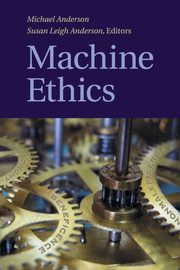Refine search
Actions for selected content:
3326 results in Artificial Intelligence and Natural Language Processing
11 - The Prisoner’s Dilemma
-
- Book:
- Computational Logic and Human Thinking
- Published online:
- 07 September 2011
- Print publication:
- 21 July 2011, pp 144-154
-
- Chapter
- Export citation
16 - Computational Logic and the selection task
-
- Book:
- Computational Logic and Human Thinking
- Published online:
- 07 September 2011
- Print publication:
- 21 July 2011, pp 198-212
-
- Chapter
- Export citation
6 - How to become a British Citizen
-
- Book:
- Computational Logic and Human Thinking
- Published online:
- 07 September 2011
- Print publication:
- 21 July 2011, pp 77-91
-
- Chapter
- Export citation
Contents
-
- Book:
- Computational Logic and Human Thinking
- Published online:
- 07 September 2011
- Print publication:
- 21 July 2011, pp vii-viii
-
- Chapter
- Export citation
Index
-
- Book:
- Computational Logic and Human Thinking
- Published online:
- 07 September 2011
- Print publication:
- 21 July 2011, pp 303-310
-
- Chapter
- Export citation
14 - Logic and objects
-
- Book:
- Computational Logic and Human Thinking
- Published online:
- 07 September 2011
- Print publication:
- 21 July 2011, pp 179-187
-
- Chapter
- Export citation
17 - Meta-logic
-
- Book:
- Computational Logic and Human Thinking
- Published online:
- 07 September 2011
- Print publication:
- 21 July 2011, pp 213-226
-
- Chapter
- Export citation
9 - The meaning of life
-
- Book:
- Computational Logic and Human Thinking
- Published online:
- 07 September 2011
- Print publication:
- 21 July 2011, pp 125-133
-
- Chapter
- Export citation
A3 - Forward and backward reasoning
-
- Book:
- Computational Logic and Human Thinking
- Published online:
- 07 September 2011
- Print publication:
- 21 July 2011, pp 257-262
-
- Chapter
- Export citation
A6 - The logic of abductive logic programming
-
- Book:
- Computational Logic and Human Thinking
- Published online:
- 07 September 2011
- Print publication:
- 21 July 2011, pp 280-295
-
- Chapter
- Export citation
Summary and plan of the book
-
- Book:
- Computational Logic and Human Thinking
- Published online:
- 07 September 2011
- Print publication:
- 21 July 2011, pp xii-xxii
-
- Chapter
- Export citation
15 - Biconditionals
-
- Book:
- Computational Logic and Human Thinking
- Published online:
- 07 September 2011
- Print publication:
- 21 July 2011, pp 188-197
-
- Chapter
- Export citation
13 - The changing world
-
- Book:
- Computational Logic and Human Thinking
- Published online:
- 07 September 2011
- Print publication:
- 21 July 2011, pp 166-178
-
- Chapter
- Export citation
A1 - The syntax of logical form
-
- Book:
- Computational Logic and Human Thinking
- Published online:
- 07 September 2011
- Print publication:
- 21 July 2011, pp 231-246
-
- Chapter
- Export citation
10 - Abduction
-
- Book:
- Computational Logic and Human Thinking
- Published online:
- 07 September 2011
- Print publication:
- 21 July 2011, pp 134-143
-
- Chapter
- Export citation
Frontmatter
-
- Book:
- Computational Logic and Human Thinking
- Published online:
- 07 September 2011
- Print publication:
- 21 July 2011, pp i-v
-
- Chapter
- Export citation
1 - Logic on the Underground
-
- Book:
- Computational Logic and Human Thinking
- Published online:
- 07 September 2011
- Print publication:
- 21 July 2011, pp 9-23
-
- Chapter
- Export citation
Exploring patterns in dictionary definitions for synonym extraction
-
- Journal:
- Natural Language Engineering / Volume 18 / Issue 3 / July 2012
- Published online by Cambridge University Press:
- 11 July 2011, pp. 313-342
-
- Article
- Export citation
Recentred local profiles for authorship attribution
-
- Journal:
- Natural Language Engineering / Volume 18 / Issue 3 / July 2012
- Published online by Cambridge University Press:
- 09 June 2011, pp. 293-312
-
- Article
- Export citation

Machine Ethics
-
- Published online:
- 01 June 2011
- Print publication:
- 09 May 2011
